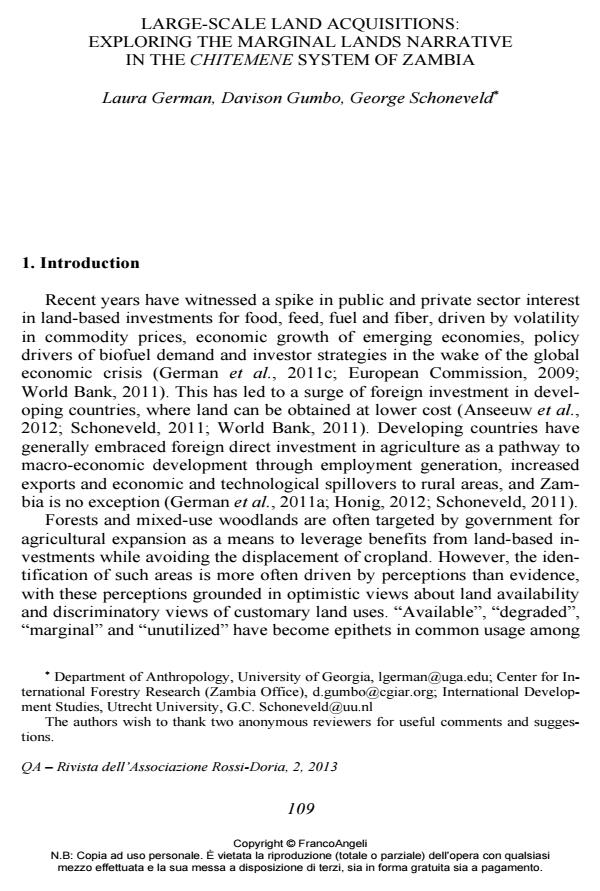Large-scale land acquisitions: exploring the marginal lands narrative in the Chitemene System of Zambia
Titolo Rivista QA Rivista dell’Associazione Rossi-Doria
Autori/Curatori Laura German, Davison Gumbo, George Schoneveld
Anno di pubblicazione 2013 Fascicolo 2013/2
Lingua Italiano Numero pagine 27 P. 109-135 Dimensione file 536 KB
DOI 10.3280/QU2013-002005
Il DOI è il codice a barre della proprietà intellettuale: per saperne di più
clicca qui
Qui sotto puoi vedere in anteprima la prima pagina di questo articolo.
Se questo articolo ti interessa, lo puoi acquistare (e scaricare in formato pdf) seguendo le facili indicazioni per acquistare il download credit. Acquista Download Credits per scaricare questo Articolo in formato PDF

FrancoAngeli è membro della Publishers International Linking Association, Inc (PILA)associazione indipendente e non profit per facilitare (attraverso i servizi tecnologici implementati da CrossRef.org) l’accesso degli studiosi ai contenuti digitali nelle pubblicazioni professionali e scientifiche
Lo Zambia è uno dei Paesi che incoraggiano fortemente i grandi investimenti esteri in agricoltura come motore di sviluppo. Tuttavia non vi sono stati studi sistematici dei costi e benefici di tali investimenti per i soggetti che usufruiscono di diritti di proprietà tradizionali. Questo lavoro si propone di colmare tale lacuna. Analizziamo il reddito delle famiglie per fonte (coltivazione a rotazione chitemene , permanente, e altri usi) in tre villaggi all’interno di una concessione in affitto acquisita da un’impresa estera interessata alla coltivazione di jatropha e lo confrontiamo con il reddito da lavoro. Successivamente, utilizziamo un approccio per scenari. I risultati suggeriscono che l’effetto finale sulle condizioni di vita dipende molto dal tipo di occupazione delle terre da parte dell’impresa; dalla misura in cui le famiglie che perdono diritti d’uso catturano le opportunità economiche emergenti; dalle specificità delle strategie economiche familiari e dalle specificità del territorio
Parole chiave:Large-scale land acquisitions, Foreign direct investment, Shifting agriculture, Zambia
- Agricultural Law Margherita Baldarelli, pp.341 (ISBN:978-3-319-64755-5)
- Reply to commentary on the special issue Scaling up biofuels? A critical look at expectations, performance and governance Ariane Goetz, Tim Searchinger, Tim Beringer, Laura German, Ben McKay, Gustavo de L.T. Oliveira, Carol Hunsberger, in Energy Policy /2018 pp.658
DOI: 10.1016/j.enpol.2018.03.046 - How have carbon stocks in central and southern Africa’s miombo woodlands changed over the last 50 years? A systematic map of the evidence Davison Gumbo, Jessica Clendenning, Christopher Martius, Kaala Moombe, Isla Grundy, Robert Nasi, Kondwani Y. Mumba, Natasha Ribeiro, Gillian Kabwe, Gillian Petrokofsky, in Environmental Evidence 16/2018
DOI: 10.1186/s13750-018-0128-0
Laura German, Davison Gumbo, George Schoneveld, Large-scale land acquisitions: exploring the marginal lands narrative in the Chitemene System of Zambia in "QA Rivista dell’Associazione Rossi-Doria" 2/2013, pp 109-135, DOI: 10.3280/QU2013-002005